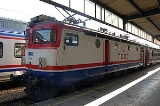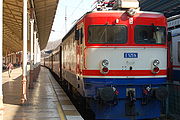
TCDD E52500
Encyclopedia
TCDD E52500 is a series of electric locomotive
s used by the Turkish State Railways
, comprising 22 class 441-9
locomotives leased from Željeznice Federacije Bosne i Hercegovine
in Bosnia-Herzegovina. They are used throughout the electrified parts of the Turkish rail network. The locomotives have a power output of 3,860 kW and are capable of 120 km/h.
The locomotives were originally built from 1967 onwards for Yugoslav Railways by ASEA
of Sweden
and Končar
in Croatia
, then part of Yugoslavia. They were based on ASEA's Rb
design for Swedish Railways.
The first fifteen locomotives were delivered to TCDD in 1998, followed by five more in 1999 and two in 2004 and 2005 respectively. They have been modernised by having the diode
s replaced with thyristor rectifier
s, making them similar to the Rc, the thyristor-based successor to the Rb.
Two units were scrapped after the Tasvancil accident in 2004. The two replacement units delivered in 2004-05 have higher top speeds that the other units, who could only run at 140 km/h.

Electric locomotive
An electric locomotive is a locomotive powered by electricity from overhead lines, a third rail or an on-board energy storage device...
s used by the Turkish State Railways
Turkish State Railways
The State Railways of the Turkish Republic or TCDD is the government owned, national railway carrier in the Republic of Turkey, headquartered in Ankara...
, comprising 22 class 441-9
HŽ series 1141
The JŽ class 441 is an electric locomotive built for Yugoslav Railways. The units are now used by Hrvatske željeznice , Željeznice Federacije Bosne i Hercegovine, Željeznice Republike Srpske, Serbian Railways, Makedonski Železnici, Turkish State Railways and Romanian Railways-CFR.-History:This...
locomotives leased from Željeznice Federacije Bosne i Hercegovine
Željeznice Federacije Bosne i Hercegovine
Željeznice Federacije Bosne i Hercegovine is the railway company of the Federation of Bosnia and Herzegovina. It is one of the two rail companies of Bosnia and Herzegovina...
in Bosnia-Herzegovina. They are used throughout the electrified parts of the Turkish rail network. The locomotives have a power output of 3,860 kW and are capable of 120 km/h.
The locomotives were originally built from 1967 onwards for Yugoslav Railways by ASEA
ASEA
Allmänna Svenska Elektriska Aktiebolaget was a Swedish industry company. It merged with the Swiss Brown, Boveri & Cie in 1988 to form Asea Brown Boveri...
of Sweden
Sweden
Sweden , officially the Kingdom of Sweden , is a Nordic country on the Scandinavian Peninsula in Northern Europe. Sweden borders with Norway and Finland and is connected to Denmark by a bridge-tunnel across the Öresund....
and Končar
Koncar
Končar may refer to:*Rade Končar, World War II Yugoslav Communist resistance fighter*KONČAR Group, an electrical engineering company of Croatia*Končar class fast attack craft, a class of military ship built for the SFR Yugoslav Navy in the 1970s...
in Croatia
Croatia
Croatia , officially the Republic of Croatia , is a unitary democratic parliamentary republic in Europe at the crossroads of the Mitteleuropa, the Balkans, and the Mediterranean. Its capital and largest city is Zagreb. The country is divided into 20 counties and the city of Zagreb. Croatia covers ...
, then part of Yugoslavia. They were based on ASEA's Rb
SJ Rb
Rb is a electric locomotive operated by Statens Järnvägar of Sweden. Six locomotives were built by ASEA, in three series designated Rb1, Rb2 or Rb3.-History:...
design for Swedish Railways.
The first fifteen locomotives were delivered to TCDD in 1998, followed by five more in 1999 and two in 2004 and 2005 respectively. They have been modernised by having the diode
Diode
In electronics, a diode is a type of two-terminal electronic component with a nonlinear current–voltage characteristic. A semiconductor diode, the most common type today, is a crystalline piece of semiconductor material connected to two electrical terminals...
s replaced with thyristor rectifier
Rectifier
A rectifier is an electrical device that converts alternating current , which periodically reverses direction, to direct current , which flows in only one direction. The process is known as rectification...
s, making them similar to the Rc, the thyristor-based successor to the Rb.
Two units were scrapped after the Tasvancil accident in 2004. The two replacement units delivered in 2004-05 have higher top speeds that the other units, who could only run at 140 km/h.
External links


